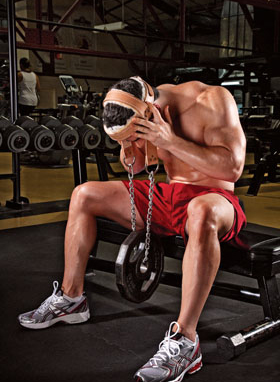The neck is a body part which is viewed constantly, and a key to support strength for many popular compound movements. Despite this importance, it’s often overlooked even by experienced bodybuilders, who either aren’t aware of its significance or don’t know how to train it. Let’s address a few frequently asked questions regarding the neck and neck training.
Why should I train the neck?
The neck should be trained for several reasons. The most important reason is to help avoid injuries. When you consider the intense workload you place on the back and chest, muscle groups directly connected to the neck, it seems maddening that one would completely neglect this adjacent muscle group. Additionally, we’ve all heard the term “pencil-neck geek” used to describe the look of a skinny person with a very thin neck. Contrast that with the look of boxer “Iron” Mike Tyson or bodybuilder Jeff Long, who both sported very thick and muscular necks, and you begin to realize the level of power and thickness that a well-developed neck can exude. The neck cannot be hidden in the way that one can keep poor calves out of sight in pants, or hide underdeveloped abs in a tank top. A weak neck shows constantly.
What do we know about the structure of the neck?
The neck is comprised of a swirling network of small, thin muscles. These include the erector spinae, splenius capitis, semispianalis cercisis, sternocleidomastois, and the trapezius. From this list, the trapezius is probably the only muscle group with which bodybuilders may be familiar. Each of these muscles works to extend the neck and head in different directions. These muscles don’t possess the propensity to gain much size, but they do possess the ability to gain a bit. A fraction of an inch on each of these muscles will add up to a great deal of muscle perception to the eye of the beholder.
How do I train the neck?
Obviously the trapezius should already be a staple in your training routine. Barbell shrugs (with the barbell gripped both in front of the body, and behind the back) are remarkably effective for stimulating the trapezius and hitting all of the neck muscles with a rush of blood to some extent. Dumbbell shrugs work as well. Manual plyometric resistance is also very helpful for the neck. Placing your hands on your forehead, side of head or back of head, apply resistance and move neck in different directions. Additionally, the neck harness works as a substitute for manual resistance, and allows for an additional workload.
What should my neck training protocol be like?
All neck exercises should always be performed in a slow, controlled motion. Any “jerking” can result in a range of maladies, ranging from a minor neck strain (which could derail chest back training for a week) to a serious neck injury requiring surgery, which could sideline your gym efforts for weeks or months. Always warm up, move through movements slowly, and use moderate weights and medium reps, in the 8 to 15 range. Low repetitions (3 to 9) mean you’re using too heavy of a weight, which can lead to injury.

